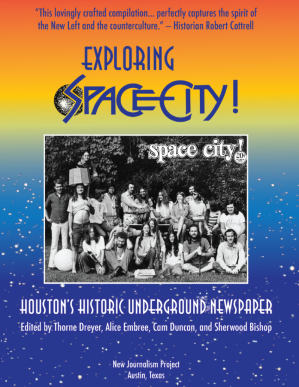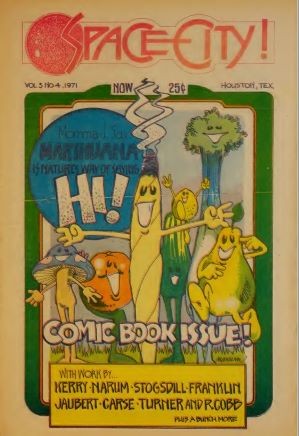An assessment of the current situation in the United States? Maybe. But this list also represents the political and societal landscape in 1969. It was in that year and in that charged environment that Space City!, Houston’s legendary underground newspaper was launched.
Space City! (originally Space City News, until it was discovered that a UFO magazine was already using that name) lasted only three years, but the comet burned brightly. The saga of Space City! is recounted in the new book, Exploring Space City!: Houston’s Historic Underground Newspaper (376 pp. $35, New Journalism Project) edited by Thorne Dreyer, Alice Embree, Cam Duncan, and Sherwood Bishop. The book is a collection of contemporary essays along with over 100 articles, photos, and illustrations originally printed in the paper. A celebration of publication will be held on Saturday, December 11, 3-6 p.m., at Johnny McElroy’s, 1223 Waugh.
Thorne Dreyer, a native Houstonian who was part of the group that founded Austin’s influential underground publication The Rag in 1966, thought that similar success could be achieved in his hometown. However, Dreyer and the other journalists who helmed Space City! found that launching their enterprise in Houston proved to be perhaps more challenging than expected.
“Houston was a very different experience from Austin,” Dreyer says. “It had the Montrose, which was kind of a bohemian center, (in contrast to) Austin, which was overrun by the counterculture at that point. There were little pockets of stuff all over the place (in Houston). There was a hip community, but it was sort of scattered around. What we wanted to do – and what we did – was to pull all of those groups together and create a political force. Not just a political force, but a cultural milieu. And over time, that worked very well.”
Dreyer was part of what was termed a “collective,” an editorial board of sorts consisting of three men and three women. Initially, the group consisted of Dreyer, Judy Fitzgerald, Dennis Fitzgerald, Victoria Smith, Susan Mithun Duncan, and Cam Duncan. “A collective is like a fancy committee,” Dreyer says. “There’s a certain political kinship involved with it. It’s consensus rule. But there wasn’t a lot of ruling. We just talked things through. We certainly had disagreements, but we always came to consensus conclusions.”
Some might have identified these young crusading journalists as hippies, but that wasn’t how they thought of themselves.
Historian John Moretta, who wrote a forward for Exploring Space City!, explains the semantics involved. “When I was researching my first book (Hippies: A 1960s History), I interviewed a lot of hippies. A lot of hippies. And they resented being called hippies. They thought it was a pejorative, a derogatory (term). They liked ‘freaks,’ ‘weirdos.’ They liked anything but 'hippies.'”
The reaction to the new paper was less than positive in many quarters. In fact, disapproval was often expressed through violence. Dreyer says that, once Space City! began publication, “the Klan started shooting us up. We were under assault from the Ku Klux Klan almost continually during our existence.” The Klan’s beef? “We were commies or something. I don’t know. Just….whatever.” The paper’s office was a frequent target of vandalism and harassment. “One time, there was a cop car at each end of the street,” Dreyer recalls, “And this car pulls in between the two cop cars and parks right in front of the Space City! office, rolls down the window, pulls out a crossbow, shoots an arrow from a crossbow right into the front door, and it has a sticker on it saying, ‘The knights of the Ku Klux Klan are watching you.’”
Did the continued attacks dim the staff’s enthusiasm for the project? “It was exactly the opposite. It made us even more committed,” Dreyer says. “What they were trying to do was to scare us and make us quit.”

Jane Fonda sat down for an interview with Space City! in 1970. According to founder Thorne Dreyer, "She was a trip."
Photo by Thorne Dreyer
“Coverage of women’s issues was continuous and diverse,” says Alice Embree, a Space City! writer and one of the editors of the new book. “It reflected an intersectional understanding before that word was coined. In the second and third issues of the paper, articles focused first on gender roles and barriers, then on women as objects of advertisers. The paper covered contraception, abortion, and forced sterilization, as well as welfare rights, health care access, and childcare. There were also articles on the treatment of women prisoners, GI's and their relationship with Asian women, labor organizing at Ma Bell, Chicana organizing, and lesbian rights.”
But Space City! wasn’t just about issues-driven investigative journalism. Sex, drugs, and rock and roll were regular topics in each issue. As for the latter, John Lomax III (bylined as John M. Lomax in those days) kept tabs on musical happenings in Houston."We were under assault from the Ku Klux Klan almost continually during our existence.”
tweet this
“’70 or ’71 was when I started writing regularly.” Lomax recalls, “And I just sort of took over and appointed myself Music Editor, and off we went.
“The Houston dailies [The Houston Post and the Houston Chronicle] weren’t covering popular music much, other than the giant shows downtown at the Music Hall or the Coliseum. FM radio was starting up pretty strong by then, and so these (new) artists and these records were getting local airplay, but absolutely ignored by the dailies. And of course there wasn’t the internet or any other source to read about this stuff if you were in Houston. No one was doing this, and I felt like, ‘This is a big city. Come on!’ Let’s get a review of the Allman Brothers. Let’s get a review of Pink Floyd.”
Reading the concert reviews in Exploring Space City!, it becomes apparent that even heading out to a rock and roll show could be an experience fraught with peril. Lomax’s review of the Rolling Stones concert at Hofheinz Pavilion in 1972 is a case in point.
“Oh yeah, back then it was pretty awful,” Lomax says. “Long hair was an advertisement for harassment by the police. Space City! (was) in the foreground, ranting and raving about the abuses, and there were plenty to write about.”
Space City! covered visits to Texas by national figures involved in progressive politics. In 1970, Jane Fonda agreed to sit down for an interview. “She was a trip,” Dreyer recalls. “She was totally genuine. Not an insincere bone in her body. I was impressed with her. There was no Hollywood-slumming-it kind of thing.”
Over the course of its three-year journey, Space City! consistently examined (some might say “exposed”) the inner workings of Houston’s power structure. Rice University, Brown and Root, and the Jesse Jones family were all subjects of the paper’s investigative journalism.
“Space City! became known for its hard-hitting exposes of Houston's wealthy ruling elite and their ties to a web of mega-corporations, banks, media, universities and private foundations — relying on research done with student radicals and grassroots organizations,” says Cam Duncan, a Space City! staffer and one of the editors of Exploring Space City!. “Student unrest and dissent were beginning to spread across the country, even at politically conservative University of Houston and Rice. Space City! was our vehicle to raise our voices against the Vietnam War — and the universities' complicity in conducting military research — when the mainstream media were parroting the government line.”
Like most underground papers, Space City! did not skimp when it came to the publication’s visual components. “We always had lots of art,” Dreyer says. “We always liked a large percentage of image in relation to print. We would run full-page cartoons.” The group of artists working at Space City! was formidable. Alums include Bill Narum (ZZ Top house artist), Jim Franklin (poster artist associated with the Armadillo World Headquarters), and Gilbert Shelton (creator of The Fabulous Furry Freak Brothers).
Midway through 1972, it all came to an end. In a piece published in Space City!’s final issue, Dreyer made it clear that the paper was heading off into the sunset. “We’ve decided to blow it all off. I mean, this is it. We’re unabashedly, unashamedly, folding.” Later in the article, he added, “We had been feeling it in our guts and it added up in our heads: a nice clean act of hari-kiri seemed in order.”
Reflecting from the perspective of 50 years later, Dreyer says, “It had just gotten to be too much of a hassle. It was hard to separate from it, because there was so much of us in it. I think we had accomplished a whole lot. I think its time had come. You know, it didn’t last that long. We accomplished a lot in a short amount of time.
“It was always hand to mouth. The paper was never designed to make money. We never thought we were going to get rich. It was all an act of love.”
A Houston launch event for Exploring Space City! will be held at 3-6 p.m. on Saturday, December 11 at Johnny McElroy’s Irish Pub & Patio, 1223 Waugh . Among those attending will be three of the book’s editors, joined by former staffers and friends of Space City! All are welcome. Food and drink will be available, and copies of Exploring Space City! will be on sale.




